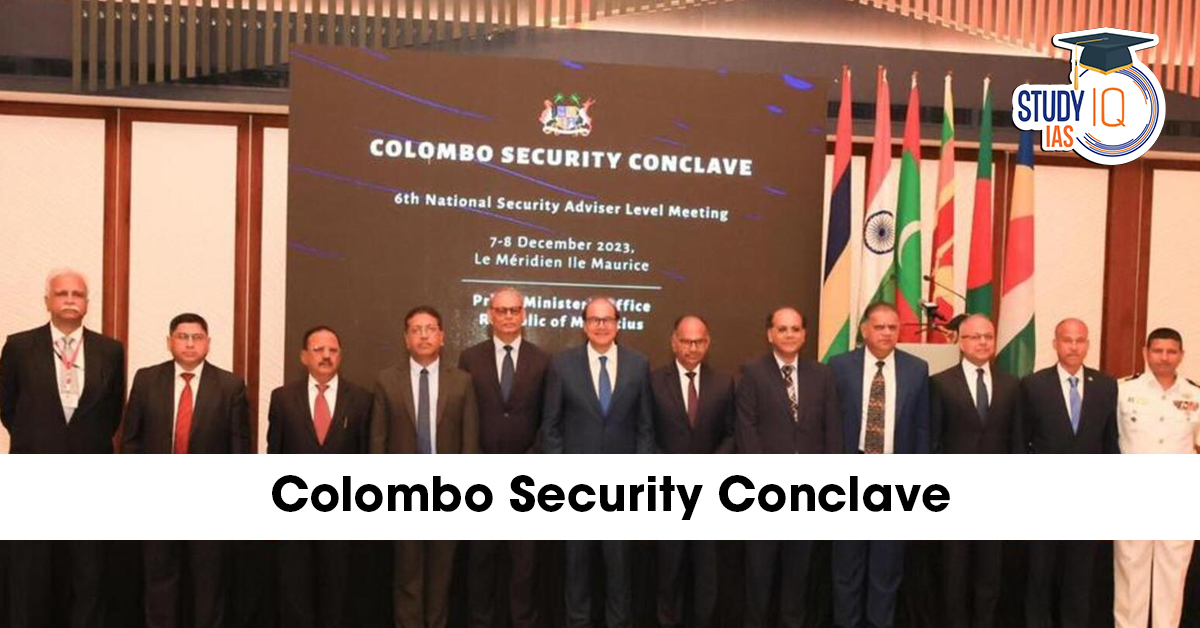Table of Contents
The Colombo Security Conclave (CSC), originally launched in 2020 as a quiet trilateral maritime security mechanism between India, Sri Lanka, and the Maldives, has rapidly evolved into one of the most significant regional security platforms in the Indian Ocean Region (IOR). In 2025, the bloc officially expanded to seven full members with the inclusion of Seychelles and Mauritius as permanent members, and Bangladesh formally elevated from observer to full member status.
Now comprising India, Sri Lanka, Maldives, Mauritius, Seychelles, Bangladesh, and with France continuing as an observer, the CSC is increasingly seen as India’s strategic answer to China’s growing influence in the Indian Ocean.
What is the Colombo Security Conclave?
Formed in 2020 (initially as a virtual meeting during the COVID-19 pandemic), the CSC focuses on five key pillars of maritime and security cooperation:
- Maritime Safety and Security
- Counter-Terrorism and Radicalisation
- Cyber Security and Critical Infrastructure Protection
- Humanitarian Assistance and Disaster Relief (HADR)
- Blue Economy and Maritime Governance
Unlike traditional military alliances, the CSC emphasizes non-traditional security threats, capacity building, joint exercises, training programs, and information sharing — making it more acceptable to smaller island nations wary of great-power rivalry.
Current Member Countries (2025)
| Country | Status | Year Joined |
|---|---|---|
| India | Founding Member | 2020 |
| Sri Lanka | Founding Member | 2020 |
| Maldives | Founding Member | 2020 (rejoined 2024 after brief exit) |
| Mauritius | Full Member | 2025 |
| Seychelles | Full Member | 2025 |
| Bangladesh | Full Member | Elevated 2025 |
| France | Observer | Since 2023 |
Why the 2025 Expansion Matters
The addition of Mauritius and Seychelles — two strategically located island nations in the western and central Indian Ocean — significantly extends India’s security and diplomatic reach from the Bay of Bengal to the Mozambique Channel.
Key strategic takeaways:
- Countering China’s “String of Pearls”: Both Mauritius and Seychelles host Chinese-funded infrastructure and have been targets of Beijing’s debt diplomacy. Their entry into CSC signals a clear preference for India-led, rules-based cooperation.
- Securing vital SLOCs (Sea Lines of Communication): The expanded CSC now covers almost the entire northern, central, and southwestern Indian Ocean trade routes.
- France as observer: Brings European naval assets and Réunion Island bases into the framework, creating an Indo-Pacific convergence.
Major Achievements of CSC (2021–2025)
- CSC Coastal Radar System Network: India-funded radar chain now operational across Maldives, Mauritius, and Sri Lanka.
- Annual Table-Top Exercises (TTX) and Joint Coastal Surveillance Drills.
- Dedicated CSC Centre of Excellence for Maritime Security established in Colombo.
- Joint humanitarian missions, including medical oxygen supply during COVID-19 and disaster response training.
- First-ever CSC Maritime Rescue Coordination Exercise held in 2024 with all members.
India’s Growing Leadership in Indian Ocean Security
National Security Advisor Ajit Doval, widely regarded as the architect of the CSC, has described it as “a cooperative, inclusive, and consultative mechanism” that respects the sovereignty of smaller nations — a direct contrast to China’s more transactional approach.
At the 7th CSC NSA-level meeting held in Colombo in October 2025, members agreed to:
- Launch a CSC Maritime Domain Awareness (MDA) Platform by 2026
- Establish a Joint Working Group on Countering Illegal Fishing and Drug Trafficking
- Conduct the first-ever CSC Multilateral Naval Exercise in 2026 (tentatively named “Ocean Guardian”)
Challenges Ahead
Despite rapid growth, the CSC faces hurdles:
- Maldives’ political volatility: The Maldives briefly left the group in 2023 under the pro-China Muizzu government but rejoined in 2024 after domestic shifts.
- Resource constraints: Smaller members depend heavily on Indian funding and training.
- China’s pushback: Beijing has criticized the CSC as an “Asian NATO in disguise,” though members reject the label.
The Road to 2030: Vision of a Secure and Prosperous Indian Ocean
The Colombo Security Conclave is no longer a side event — it is now the primary indigenous security architecture of the Indian Ocean Region.
With climate change, piracy resurgence, illegal fishing, and great-power competition intensifying, experts believe the CSC model — flexible, non-aligned, and focused on common threats — is exactly what the region needs.
As one Mauritian official put it after the 2025 expansion: “We are small islands, but together with India and our partners, we are no longer alone in a big ocean.”
Key Takeaways – Colombo Security Conclave 2025
- Expanded to 7 members: India, Sri Lanka, Maldives, Mauritius, Seychelles, Bangladesh + France (observer)
- Focus: Maritime security, HADR, counter-terrorism, cyber, blue economy
- India-funded radar networks and training now span the entire Indian Ocean
- Seen as strategic counterweight to China’s influence in IOR
- First multilateral naval exercise planned for 2026
The Indian Ocean is witnessing the rise of a new security order — and it speaks with an Indian accent.
Tags: Colombo Security Conclave | Indian Ocean Security | India Maldives Mauritius Seychelles | Maritime Security India | Counter China Indian Ocean | Ajit Doval NSC | CSC Expansion 2025 | Blue Economy Cooperation


 Electronics Development Fund (EDF)
Electronics Development Fund (EDF)
 Belem Action Plan for Health and Climate...
Belem Action Plan for Health and Climate...
 Atlantic Meridional Overturning Circulat...
Atlantic Meridional Overturning Circulat...

























